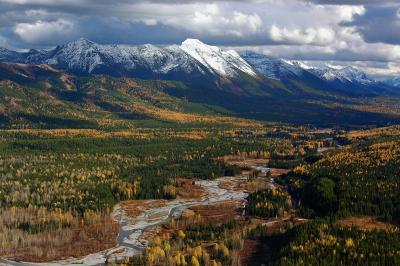Protecting and connecting the Flathead National Forest

This image depicts a landscape in Flathead National Forest. Credit: Harvey Locke
A new report from the Wildlife Conservation Society (WCS) calls for completing the legacy of Wilderness lands on the Flathead National Forest in Montana. The report identifies important, secure habitats and landscape connections for five species—bull trout, westslope cutthroat trout, grizzly bears, wolverines, and mountain goats. These iconic species are vulnerable to loss of secure habitat from industrial land uses and/or climate change.
Located in northwest Montana adjacent to Glacier National Park, the 2.4 million-acre Flathead Forest is a strategic part of the stunning and ecologically diverse Crown of the Continent Ecosystem. From the 1930's to the present, generations of citizens and government leaders have worked to protect this special area through designations of wilderness, wild and scenic rivers, and protection of critical wildlife habitat.
In his report, “Conservation Legacy on a Flagship Forest: Wildlife and Wild Lands on the Flathead National Forest, Montana,” WCS Senior Scientist Dr. John Weaver notes that these protections may not be enough in the face of looming challenges such as climate change.
For example, warmer winters will reduce mountain snow cover and suitable habitat for the rare wolverine – a species highly adapted to persistent snow pack. Reduced stream flow and warmer stream temperatures will diminish habitat for native westslope cutthroat trout and bull trout that are well adapted to cold waters – while favoring introduced rainbow trout and brook trout.
Weaver found that the Flathead is a stronghold for these fish and wildlife species that have been vanquished in much of their range further south. His analysis shows that 90 percent of the Flathead has a “very high” or “high” conservation value for at least one of the five focal species.
In his recommendations, Weaver employs a “smart strategy for resiliency” that protects and connects large landscapes that have high topographic and ecological diversity. Such a strategy will provide a range of options for animal movements as conditions change. Importantly, remaining roadless areas account for nearly 25 percent of the best habitats for these species. In particular, these higher-elevation areas will provide key options for such vulnerable species in a warmer future.
In total, Weaver recommends 404,208 acres of roadless area on the Flathead Forest for Congressional designation as National Wilderness, and another 130,705 areas be conserved in roadless condition as legislated “Backcountry Conservation.” Vital places with particular concentration of present and future habitat include the Whitefish Range adjacent to Glacier National Park and the Swan Range east of Flathead Lake.
“This report will help inform discussions and decisions about future management on the Flathead National Forest,” said Weaver. “These spectacular landscapes provide some of the best remaining strongholds for vulnerable fish and wildlife and headwater sources of clean water. These roadless refugia offer a rare opportunity to complete the legacy of protecting wildlife and wildlands on this crown jewel of the National Forest system for people today and generations yet to come.”
This important conservation assessment was generously supported by the LaSalle Adams Fund, Cross Charitable Foundation, The William and Flora Hewlett Foundation, and the Wilburforce Foundation. The opinions expressed in the report are those of the author and do not necessarily reflect the views of the supporters.
Media Contact
All latest news from the category: Ecology, The Environment and Conservation
This complex theme deals primarily with interactions between organisms and the environmental factors that impact them, but to a greater extent between individual inanimate environmental factors.
innovations-report offers informative reports and articles on topics such as climate protection, landscape conservation, ecological systems, wildlife and nature parks and ecosystem efficiency and balance.
Newest articles

Properties of new materials for microchips
… can now be measured well. Reseachers of Delft University of Technology demonstrated measuring performance properties of ultrathin silicon membranes. Making ever smaller and more powerful chips requires new ultrathin…

Floating solar’s potential
… to support sustainable development by addressing climate, water, and energy goals holistically. A new study published this week in Nature Energy raises the potential for floating solar photovoltaics (FPV)…

Skyrmions move at record speeds
… a step towards the computing of the future. An international research team led by scientists from the CNRS1 has discovered that the magnetic nanobubbles2 known as skyrmions can be…





















